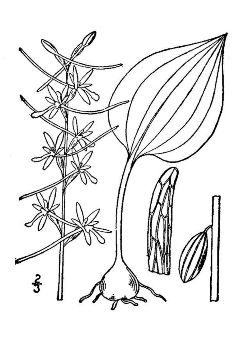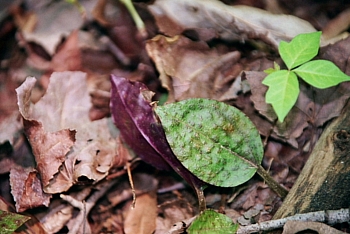
|

|
| Photo
by Renee Brecht |
Britton and Brown. See
credits below. |
 |
Left: Tipularia
discolor leaves.
Note the deep madder-purple leaf to the left; that is the underside of T. discolor leaf.
To its right is a rather "bumpy" looking leaf, which is the top of a T. discolor
leaf. |
| Botanical name: |
Tipularia
discolor |
| Common
name: |
Cranefly
orchid
|
| Synonomy |
Tipularia unifolia
B.S.P. |
| Group: |
Monocot |
| Family: |
Orchidaceae |
| Growth
Type: |
Forb/herb |
| Duration: |
Perennial |
| Plant
height: |
15-20
inches |
| Flower
color: |
greenish,
tinged with madder-purple, numerous in an elongated loose bractless
raceme. |
| Flower
size: |
1/2"
across; 1-3 cm. long, spur about 2 cm. long
|
| Flowering/fruiting time |
Early
July -Early August
|
| Habitat: |
Hardwood
forests
|
| Range in
New Jersey: |
Northern
and middle districts and lower Cape May peninsula.
|
| Heritage ranking if any: |
S3
|
| Misc.: |
USDA
lists as a facultative upland species.Usually occurs in
non-wetlands (estimated probability 67%-99%), but occasionally found on
wetlands (estimated probability 1%-33%).
Species name discolor is "di-scolor" rather than "dis-color", refering
to the two colors, from the contrast of the upper and lower leaf
surfaces)
Leaf is 5-13 cm. long, disappearing before anthesis; often it is easier
to find this plant in the winter by looking for its unusual leaf while
all around it is brown. Leaf emerges in fall and persist through the
winter, withering in the spring. Leaf is gone by the time it flowers.
Stone notes: "This curious orchid was found in lower Cape May County a
number of years ago by Mr. Joseph Crawford, but was not discovered
again until detected by Mr. O.H. Brown, who has in the last few years
found it at a number of scattered stations in the dark oak and pine
woods of the lower third of the peninsula. The single leaf arises in
autumn and persists throughout the winter, but perishes before the
flowers appear. The absence of any foliage and the spidery character
and obscure coloring of the flowers makes it an exceedingly difficult
plant to detect.
Pursh's type locality was Pine Barrens of New jersey, but he probably
used the term loosely."(378) |
Not sure what a word means? Use Answers.com:
|
| Sources |
|
|
|
|
|